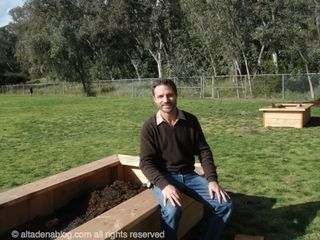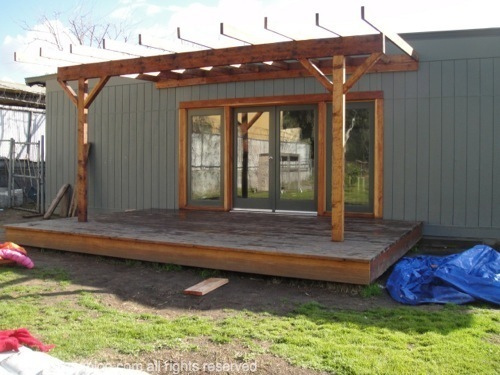A year after winning a $10,000 grant, the teacher integrates language, gardening, theater, and nature into a wholistic experience for his students.
by Laura Monteros

Odyssey School teacher Darryl Bilandzija used his grant to integrate language arts with nature. Photos by Laura Monteros.
Teacher Daryl Bilandzija of Odyssey Charter School has a different approach. With money from a $10,000 GOOD Magazine grant he received last April, he installed wide glass doors that open onto an outdoor stage overlooking the garden behind his language arts classroom. The annual theater productions he instituted when he came to Odyssey four years ago will take place on the stage, and the garden he started provides both food and learning.
“Everything goes back to the garden,” he said when we spoke with him on Friday. Lessons learned in the garden and in building raised beds or a chicken tractor integrate into Bilandzija’s middle school curriculum.
Lazy man's gardening
The garden is a strip of land that’s part of the grassy area at the back of the campus. It has 40 different fruit trees, several raised beds with benches so students can converse as they garden, and vegtables growing around the trees. The beds and several plots are sheet-mulched, which Bilandzija calls “lazy man’s gardening.” Flattened cardboard boxes topped with compost provided by Altadena compostmeister Tim Dundon smother the grass and turn it into nitrogen. By late spring, Bilandzija hopes to have the entire garden area sheet-mulched.
Eventually, each tree will be surrounded by cloverleaf planting areas. The cloverleaf shape provides microclimates that get varying amounts of sun and shade from the tree. His goal is to grow enough food to sell at the Altadena Farmer’s Market, but he sees something even more important occurring with the garden.
“Natural discovery is more important to me as a teacher,” he said. “One of the things I like about the space is that it becomes an unofficial adventure playground for kids.” He referred to open areas in London that are designed for children to explore and play with raw materials freely. “Kids spontaneously create things—forts, dig holes,” Bilandzija said. “It serves that purpose too.”
Chicken tractor
While we were there, we observed several children examining the pink blossoms on a fruit tree, playing with friends, or just running on the grass between the trees. We also observed several very happy and fat hens in the fenced chicken yard next to the portable building that houses Bilandzija’s room.
The hens do more than cluck, eat, and lay eggs. They help in the garden, too. The students built a chicken tractor out of scrap wood and wire found on the campus, a rather ingenious invention. The rectangular floorless pen on wheels uses chicken power to prepare the ground for planting. The chickens scratch up the grass, loosen the soil, and provide fertilizer. When one patch is prepared, the pen is moved to another place in the yard.
Bilandzija envisions that the stage, which was part of the project, will be the “multipurpose room of the future” for observation, reading, and outdoor classes as well as the annual production. His plans for the 2013 event is for students to write, direct, and act out mini-skits. “I want them to experience it. It’s so much more fun when they do it,” he said. The garden provides many of the ingredients for the dinner served at the productions. “The kids could say that the food they were eating came from the garden,” he said.
Wholistic education
“Odyssey has really given me the opportunity to be creative and experimental,” he said. His English curriculum includes researching and writing a paper on a thesis statement, but he also integrates other disciplines. Students used geometry to layout and build the garden beds, and they learn about science in working the land and caring for the chickens. They probably learn a bit about genetics, as well, when they observe that the red hens lay brown eggs and the Arucana lays green eggs. Lessons in ecology include the plan in the works to construct a low-tech, gravity rainwater reclamation system with two 500-gallon cisterns to harvest water off the roof, and the glass doors that provide enough natural light to turn the classroom lights off from 10 a.m. to 2 p.m. on some days.
Bilandzija seeks to provide light in other ways, too. “Kids are bombarded with dark images of the future, apocalyptic images,” he said. Kids need to know the problems, he said, but they also need to be empowered to find solutions. He calls this a “blind spot” in education—“we’re good at analyzing problems, but not solutions.”
His passion for teaching is to give a classroom of kids hope for the future. “It’s the opposite of bleak. Let’s change that narrative a bit.” The garden is a “demonstration site” in problem-solving, he said. It helps a child “believe you can accomplish it on your own.”
Looking out on the trees, he said that the garden is a legacy that the older students, who won’t see it mature, leave behind for the younger ones coming up. “It’s a part of the orchard I really like,” he said. “It all goes back to the garden.”
1. The north door of Bilandzija's classroom opens out onto an outdoor stage.
2. The "chicken tractor," a moveable coop that uses chickens to prepare the ground.
3. Cloverleaf garden design.
4. The view of the garden, looking north.
5. The hens are an imporant part of the garden complex.
6. The view from Bilandzija's classroom.










